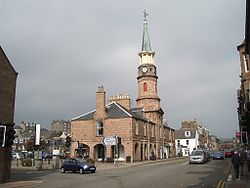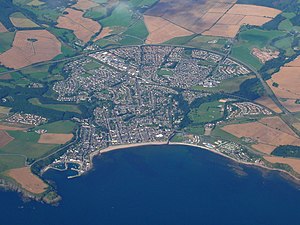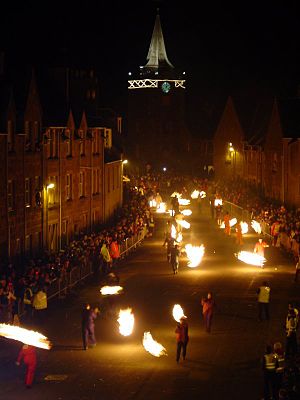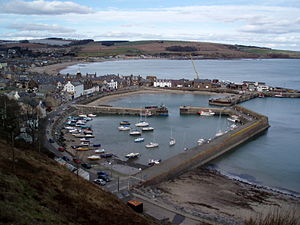Stonehaven: Difference between revisions
mNo edit summary |
mNo edit summary |
||
| Line 17: | Line 17: | ||
| LG district = Aberdeenshire | | LG district = Aberdeenshire | ||
}} | }} | ||
'''Stonehaven''' is a town on the coast of [[Kincardineshire]], of which it is the county town | '''Stonehaven''' is a town on the coast of [[Kincardineshire]], of which it is the county town | ||
| Line 42: | Line 41: | ||
===Dunnottar Castle=== | ===Dunnottar Castle=== | ||
Dunnottar Castle, perched atop a rocky outcrop, was home to the Keith family, and during the Scottish Wars of Independence, the Scottish Crown Jewels were hidden there. In 1296, King Edward I of England took the castle only for William Wallace to claim it in 1297, burning the church down in the process with the entire English garrison still in it. In 1650, Oliver Cromwell sacked the castle to find the Crown Jewels following an eight month siege (having previously destroyed the English Crown Jewels). However, just before the castle fell, the Crown Jewels were smuggled out by some ladies who took them by boat to a small church just down the coast in the village of Kinneff, where they remained undetected for eleven years. | Dunnottar Castle, perched atop a rocky outcrop, was home to the Keith family, and during the Scottish Wars of Independence, the Scottish Crown Jewels were hidden there. In 1296, King Edward I of England took the castle only for William Wallace to claim it in 1297, burning the church down in the process with the entire English garrison still in it. In 1650, Oliver Cromwell sacked the castle to find the Crown Jewels following an eight month siege (having previously destroyed the English Crown Jewels). However, just before the castle fell, the Crown Jewels were smuggled out by some ladies who took them by boat to a small church just down the coast in the village of Kinneff, where they remained undetected for eleven years. | ||
===Cowie=== | ===Cowie=== | ||
Near the Cowie Bridge, at the north of Stonehaven, is a historic fishing village known as Cowie, which has by now been swallowed into Stonehaven. Northward are the ruins of Cowie Castle. Slightly to the west of Stonehaven is the ruined Ury House, originally a property of the Clan Fraser. | Near the Cowie Bridge, at the north of Stonehaven, is a historic fishing village known as Cowie, which has by now been swallowed into Stonehaven. Northward are the ruins of Cowie Castle. Slightly to the west of Stonehaven is the ruined Ury House, originally a property of the Clan Fraser. | ||
| Line 52: | Line 49: | ||
==Churches== | ==Churches== | ||
* [[Church of Scotland]]: | * [[Church of Scotland]]: | ||
** Dunnottar Parish Church | ** Dunnottar Parish Church | ||
Revision as of 10:27, 11 October 2010
| Stonehaven Gaelic: Cala na Creige Scots: Steenhive | |
| Kincardineshire | |
|---|---|
 Market Square, Stonehaven | |
| Location | |
| Grid reference: | NO8786 |
| Location: | 56°57’36"N, 2°12’36"W |
| Data | |
| Population: | 9,577 (2001) |
| Post town: | Stonehaven |
| Postcode: | AB39 |
| Dialling code: | 01569 |
| Local Government | |
| Council: | Aberdeenshire |
| Parliamentary constituency: |
W. Aberdeenshire & Kincardine |
Stonehaven is a town on the coast of Kincardineshire, of which it is the county town
Stonehaven grew around a fishing village inhabited at least since the Iron Age, the site now known as the "Auld Toon", and it expanded inland from the sea coast. As late as the 16th century, old maps indicate the town was called Stonehyve or Stonehive.
Geography

Stonehaven is 15 miles south of Aberdeen in a sheltered position on Stonehaven Bay between the Carron Water and the Cowie Water. Stonehaven lies adjacent to a deeply indented bay surrounded on three sides by higher land between Downie Point and Garron Point. The harbour, consisting of two basins, was improved in the 1820s by the engineer Robert Stevenson and became an important centre of the 19th century herring trade;[1] the harbour is bordered on the north by Bellman's Head and at the south by Downie Point.
At the western edge of Stonehaven west of the A90 road lies the village of Kirkton of Fetteresso.
Stonehaven has grown rapidly since the oil boom in Aberdeen. The increasing demand for new, middle-class housing has seen four new estates being appended to the town, creating an expanse of suburbs.
History
Stonehaven is the site of prehistoric events as witnessed by finds at Fetteresso Castle and neolithic pottery excavations from the Spurryhillock area.[2]
The town lies at the southern origin of the ancient Causey Mounth trackway, which was built on high ground to make passable this only available mediaeval route from coastal points south to Aberdeen. This ancient passage specifically connected the Bridge of Dee to Cowie Castle by way of the Portlethen Moss and Stonehaven.[3] As the one coastward route to the north, it has been of vital strategic importance. It was the route was that taken by the 9,000-strong Covenanter army to the battle of the Wars of the Three Kingdoms in 1639.[4]
The surviving Covenanters were imprisoned in the fetid dungeons of Dunnottar Castle, where many died, memorialised now in Dunnottar Church.
Other castles in the vicinity are Fetteresso Castle and Muchalls Castle, both of which are in private ownership and not open to the public.
The oldest surviving structure in Stonehaven is the Stonehaven Tolbooth at the harbour, used as an early prison and now a museum.
Dunnottar Castle
Dunnottar Castle, perched atop a rocky outcrop, was home to the Keith family, and during the Scottish Wars of Independence, the Scottish Crown Jewels were hidden there. In 1296, King Edward I of England took the castle only for William Wallace to claim it in 1297, burning the church down in the process with the entire English garrison still in it. In 1650, Oliver Cromwell sacked the castle to find the Crown Jewels following an eight month siege (having previously destroyed the English Crown Jewels). However, just before the castle fell, the Crown Jewels were smuggled out by some ladies who took them by boat to a small church just down the coast in the village of Kinneff, where they remained undetected for eleven years.
Cowie
Near the Cowie Bridge, at the north of Stonehaven, is a historic fishing village known as Cowie, which has by now been swallowed into Stonehaven. Northward are the ruins of Cowie Castle. Slightly to the west of Stonehaven is the ruined Ury House, originally a property of the Clan Fraser.
The fossil of what is said to be the oldest air-breathing invertebrate discovered was found at Stonehaven's Cowie Beach; pneumodesmus newmani, a species of millipede.[5][6]
Churches
- Church of Scotland:
- Dunnottar Parish Church
- South Parish Church
- Fetteresso Parish Church,
- Baptist Church
- Episcopal Church of Scotland
- Evangelical Church of Scotland
- Roman Catholic Church.
Commerce and culture
Historically the chief commerce of Stonehaven lay in fishing. Led by the herring fishery, the catch peaked around the year 1894 with a peak catch of about 15 million fish per annum and an employment in the fishing industry of 1280 people. Due to overfishing to serve the population|expanding regional population, the fishing industry declined with diminishing catches, such that by 1939 only a remnant of the earlier fishing fleet continued to exist,[4] and the catch mostly supported the local population from that point onward.
At present day the town's primary industries are marine services and tourism, with Dunnottar Castle, a local landmark, bringing in a large number of tourists every year. Dunnottar Castle is regularly used in promotional material by the Scottish tourism industry; in addition, it was used in Kenneth Branagh's 1990 film of Hamlet.
In and around the town



Attractions include:
The town has a long beach facing the North Sea, with large cliffs at either end sheltering small rock pools and inlets.
It has olympic-sized outdoor swimming pool, heated and filled with a mixture of tap water and filtered seawater.
The local harbour features the Tolbooth, the town's tiny museum of local heritage.
During Hogmanay festivities, the High Street comes alive with crowds watching the annual fireballs ceremony, in which volunteers walking down the High Street swing huge balls of fire around and around at the ends of chains. The fireballs are finally thrown into the harbour[7].
Every July Stonehaven holds a Highland Games. All those competing in the heavy events (which include the Hammer, the Heavy Stone and tossing the caber) must wear full Highland dress. Other events include the Stonehaven Folk Festival regularly attended by the Glaswegian comedian Billy Connolly. On the first Saturday in June the Feein' Market recreates a 19th Century agricultural hiring fair. The RW Thomson Classic Car Rally is an annual celebration of the inventor of the pneumatic tyre and attracts an impressive range of vintage and classic cars. There are two harbour festivals each summer. A farmers market is now held once a month in the market square where local food suppliers and producers can sell fresh fruit, vegetables, poultry and other types of meat.
The town's Haven Fish Bar has been blamed for inventing the Deep-fried Mars Bar,[8] an item more usually associated with Glasgow. The Haven has since closed and been replaced by a respectable chip shop.
Stonehaven's long established pipe band plays at events throughout the year, including the folk festival and fireball ceremony. The band has competed at various levels throughout its illustrious history including several years at the prestigious Grade 1.
References
- ↑ Gazeteer for Scotland. "Stonehaven". http://www.geo.ed.ac.uk/scotgaz/towns/townfirst184.html. Retrieved 2007-04-28.
- ↑ Clarke, C M 1997 "Palaeoenvironmental results" in Alexander, D 'Excavation of pits containing decorated Neolithic pottery and early lithic material of possible Mesolithic date at Spurryhillock, Stonehaven, Aberdeenshire', PSAS 127, 17-27
- ↑ C.Michael Hogan, History of Muchalls Castle, Aberdeen (2005)
- ↑ 4.0 4.1 Archibald Watt, Highways and Biways around Kincardineshire, Stonehaven Heritage Society (1985)
- ↑ Pneumodesmus article on Independent news website
- ↑ Pneumodesmus article on science section of Red Orbit website
- ↑ '[1]' at Stonehaven Fireball Association.
- ↑ French batter Mars bars menu publisher:BBC B News http://news.bbc.co.uk/1/hi/scotland/654750.stm BBC News